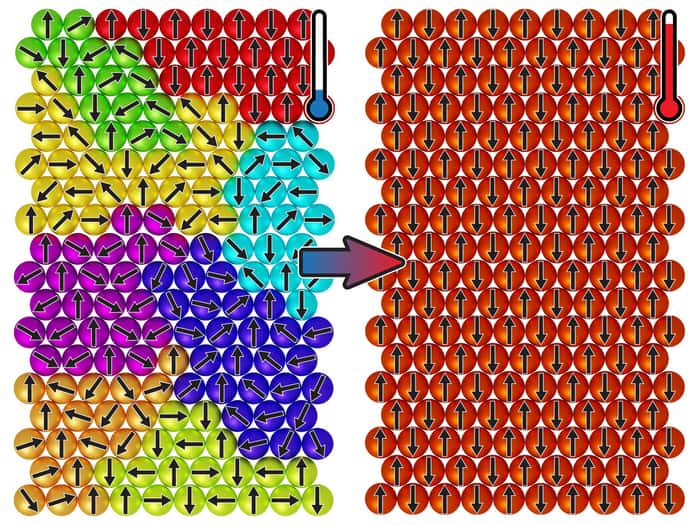
Usually, when materials heat up, they become more disordered. Now, researchers at Radboud University in the Netherlands have found evidence for the opposite happening in the element neodymium, which develops long-range order as its temperature increases. The presence of this phase transition could shed light on the behaviour of materials known as spin glasses and could also aid the development of devices for information storage or neuromorphic computing.
Spin glasses such as neodymium (Nd) are a special class of magnetic materials in which particle spins form random, helix-like patterns below a certain critical temperature (termed the spin glass temperature). They are often considered to be disordered magnets and are different from other such “frustrated” magnets such as spin ices and spin liquids.
Recently, researchers led by Alexander Khajetoorians at Radboud discovered that Nd is a self-induced spin glass – meaning that the spin glass state comes about thanks to competing spin-exchange interactions that arise from the material’s own lattice structure. These interactions mean that Nd can exist in multiple low-energy states defined by its reciprocal lattice vector (or magnetic wavevector) Q.
Spins “freeze” into a solid
In the latest study, Khajetoorians and his colleagues observed the spins “freeze” into a solid as they heated the element from -268 °C to -265 °C. When they cooled it down again, the random spin whirling patterns reappeared.
Khajetoorians notes that the appearance of this disorder-order transition in Nd defies the common perception that increasing temperature induces disorder. Such a transition does not normally occur in magnetic materials, he adds, and it is also uncommon in other materials. One exception is Rochelle salt, which contains charges that are randomly distributed at lower temperatures, but build up and form an ordered pattern as the temperature increases.
In Nd, the behaviour is linked to a phenomenon in which many different states have the same energy, causing the system to become frustrated, the researchers say. An increase in temperature lifts the frustration with one ordering tendency surviving, allowing the spins to settle into an ordered pattern over a long range. “Specifically, the new state is a so-called multi-Q one,” Khajetoorians tells Physics World. “There is a high-energy phase at low temperature and vice versa.”
Applications in information storage and neuromorphic computing
The Radboud team used spin-polarized scanning tunnelling microscopy (STM) to probe the magnetic texture on the surface of Nd. They developed two analysis tools that allowed them to extract the spin glass transition temperature directly from their measured data at different temperatures. They observed many different and smoothly varying patterns in the element at 5 K (-268 °C) and fewer patterns at higher temperatures that were clearly separated by magnetic domain walls.

Researchers find ‘lost’ angular momentum
The researchers also compared their observations with atomistic spin dynamics simulations to help them trace the origins of the unexpected high-temperature order.
Khajetoorians says that he and his team will now be studying what happens when Nd is made thinner since this might induce some further unexpected effects. They would also like to test other magnetic materials to see if they exhibit the same spin-glass behaviour, which they say could be harnessed for new types of information storage or to develop neuromorphic computers.
The work is detailed in Nature Physics.
